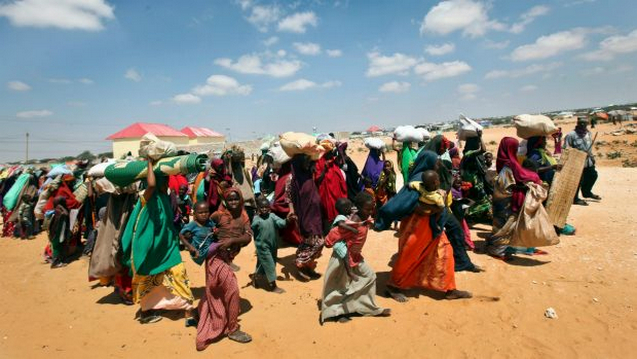 |
| ‘Tropics’ may conjure images of sun-kissed islands, but the expanding tropical zone could bring drought and cyclones further south. Pedro Fernandes/Flickr, CC BY-SA |
However, tropical climates occur within a larger area about 30 degrees either side of the Equator. Earth's dry subtropical zones lie adjacent to this broad region. It is here that we find the great warm deserts of the world.
Earth's bulging waistline
Earth's tropical atmosphere is growing in all directions, leading one commentator to cleverly call this Earth's "bulging waistline".
Since 1979, the planet's waistline been expanding poleward by 56km to 111km per decade in both hemispheres. Future climate projections suggest this expansion is likely to continue, driven largely by human activities – most notably emissions of greenhouse gases and black carbon, as well as warming in the lower atmosphere and the oceans.
If the current rate continues, by 2100 the edge of the new dry subtropical zone would extend from roughly Sydney to Perth.
As these dry subtropical zones shift, droughts will worsen and overall less rain will fall in most warm temperate regions.
Poleward shifts in the average tracks of tropical and extratropical cyclones are already happening. This is likely to continue as the tropics expand further. As extratropical cyclones move, they shift rain away from temperate regions that historically rely upon winter rainfalls for their agriculture and water security.
Researchers have observed that, as climate zones change, animals and plants migrate to keep up. But as biodiversity and ecosystem services are threatened, species that can't adjust to rapidly changing conditions face extinction.
In some biodiversity hotspots – such as the far southwest of Australia – there are no suitable land areas (only oceans) for ecosystems and species to move into to keep pace with warming and drying trends.
We are already witnessing an expansion of pests and diseases into regions that were previously climatically unsuitable. This suggests that they will attempt to follow any future poleward shifts in climate zones.
I recently drew attention to the anticipated impacts of an expanding tropics for Africa. So what might this might mean for Australia?
 |
| IPCC |
Australia's geographical location makes it highly vulnerable to an expanding tropics. About 60% of the continent lies north of 30°S.
As the edge of the dry subtropical zone continues to creep south, more of southern Australia will be subject to its drying effects.
Meanwhile, the fringes of the north of the continent may experience rainfall and temperature conditions that are more typical of our northern neighbours.
The effects of the expanding tropics are already being felt in southern Australia in the form of declining winter rainfall. This is especially the case in the southwest and — to a lesser extent — the continental southeast.
Future climate change projections for Australia include increasing air and ocean temperatures, rising sea levels, more hot days (over 35℃), declining rainfall in the southern continental areas, and more extreme fire weather events.
For northern Australia, changes in annual rainfall remain uncertain. However, there is a high expectation of more extreme rainfall events, many more hot days and more severe (but less frequent) tropical cyclones and associated storm surges in coastal areas.
Dealing with climate change
Adaptation to climate change will be required across all of Australia. In the south the focus will have to be on adapting to projected drying trends. Other challenges include more frequent droughts, more warm spells and hot days, higher fire weather risk and rising sea levels in coastal areas.
The future growth of the north remains debatable. I have already pointed out the lack of consideration of climate change in the White Paper for the Development of Northern Australia.
The white paper neglects to explain how planned agricultural, mining, tourism and community development will adapt to projected changes in climate over coming decades — particularly, the anticipated very high number of hot days.
For example, Darwin currently averages 47 hot days a year, but under a high carbon emission scenario, the number of hot days could approach 320 per year by 2090. If the north is to survive and thrive as a significant economic region of Australia, it will need effective climate adaptation strategies. This must happen now — not at some distant time in the future.
This requires bipartisan support from all levels of government, and a pan-northern approach to climate adaptation. It will be important to work closely with industry and affected local and Indigenous communities across the north.
These sectors must have access to information and solutions drawn from interdisciplinary, "public good" research. In the face of this urgent need, CSIRO cuts to such research and the defunding of the National Climate Change Adaptation Research Facility should be ringing alarm bells.
As we enter uncharted climate territory, never before has public-good research been more important and relevant.
Links
- Circles of Latitude & Longitude - The Equator, The Prime Meridian, The Tropic of Cancer and Capricorn
- The mystery of the expanding tropics
- Expansion of the tropics: revisiting frontiers of geographical knowledge
- Cities rally around the Paris deal, a reminder that global problems can have local solutions
- Contributions to sea-level rise have increased by half since 1993, largely because of Greenland's ice
- China in climate driver's seat after Trump rejects Paris


















